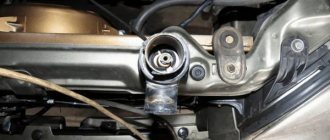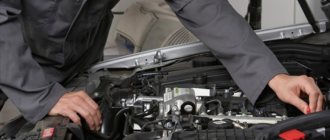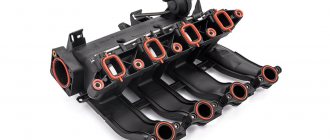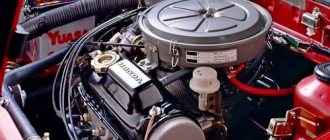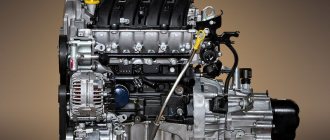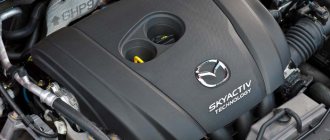The structure of the car, diagram of units and components
In modern society, a car has ceased to be a luxury. Now every family has at least one car for everyone. And it is no longer uncommon for every adult family member to have their own vehicle. This is not surprising, the pace of life is growing, mobility and convenience have become paramount. Almost everyone, from school, already dreams of obtaining a driver's license and the opportunity to drive their own car. But not everyone pays due attention and desire to study the design and composition of the machine during training. As a rule, the first exam in “field conditions” to detect a sudden breakdown fails. Most don't even know where to start or where to look. In order not to become a hostage to an unpleasant situation and get out of it with dignity, you need to know the basic structure of the car.
Main units and components of the machine
Literally after some 20-30 minutes of studying, you will understand that the composition and design of a car is not so complicated. Conventionally, the device of the machine can be divided into the following basic units:
- The engine is the heart of the car. That part of the car that makes your heart flutter when you press the gas pedal hard. In this unit, the prepared fuel mixture is burned. Depending on the type of fuel used, engines are divided into gasoline and diesel options. The engine converts the energy received from fuel combustion into rotational energy.
- The transmission is an intermediate mechanism that reduces engine torque and transmits it to the wheels. There are about 5 types of transmission. The transmission includes: clutch, gearbox, final drive, transfer mechanism, differential, cardan transmission and angular velocity joint.
- The chassis is a set of mechanisms that interact between the wheels of the car and the load-bearing part. There are two types of suspensions: dependent and independent. The dependent suspension scheme implies rigid fastening of the wheel-beam-body system. Modern car models use independent suspension, in which case each wheel has its own mounting pattern to the body and a spring element.
- Steering is a set of mechanisms designed to change the direction of movement of the car. The driver's force is transmitted through the steering wheel to the steering mechanism, then to the steering gear and directly to the wheels themselves.
- Braking system - designed to reduce the speed of movement, up to a complete stop. The brake system is usually divided into two types: working and parking. The service brake system includes those elements that are involved in braking the car while driving using the pedal: brake discs, pads, drums, cylinders, etc. The parking brake system is used to hold the vehicle on an uneven surface when the movement is stopped.
- Electrical equipment is a set of components and mechanisms designed directly to start a car, operate some electrical appliances and lighting. It is also difficult to imagine a modern car without a security alarm. The source of electricity is the battery, which is constantly charged and stores energy while driving through the generator. The electrical circuitry in cars is quite difficult for beginners to understand.
- The body is a part of the car that performs two main functions: it is a platform for placing and fastening almost all components and assemblies that form the structure of the car and performs safety functions. Currently, the body is the place where design and engineering ideas are embodied.
The considered composition and structure of the car is superficial. The main basic complexes and units, circuits that are responsible for their specific responsibilities are identified. Naturally, all these units include smaller parts of various designs. For a more detailed study of the car, its mechanisms, and electrical circuits, it is necessary to spend much more time. But even a superficial study of the basic components and assemblies will allow you to better understand the specifics of the operation of the machine as a whole.
autolirika.ru
Power and exhaust system
A power supply system is used to supply and dispense fuel. It consists of a fuel tank, fuel pumps, filters, a fuel line and a device that dispenses and mixes fuel with air. For gasoline engines, this is a carburetor or injection system, and for diesel engines, it is a high-pressure fuel pump and injectors that supply diesel fuel to the cylinders.
To remove exhaust gases away from the cabin, there is an exhaust system, which, among other things, also muffles the noise of the engine, and it has something to muffle - several thousand powerful explosions occur in the engine every minute. In addition, the exhaust system of modern cars controls the level of emissions of harmful substances, fuel combustion products, into the atmosphere.
What are the main components in a car?
What important blocks does a car consist of, their purpose, role in the operation of the car? These are questions that arise for beginners who have recently gotten behind the wheel and are faced with the need to study its structure. There are many questions, they are complex, but interesting. Let's try to give short but comprehensive answers.
Every day, residents of a city, even a small one, are faced with traffic flow. Ordinary people who are far from traveling by car on their own do not think about its design. It seems to them that cars (from cars to buses) are made according to the same principle and consist of similar modules. Starting to gain first driving experience, a person realizes that they are all different.
A car
What car components can an amateur name? As a rule, his imagination does not go further than: body, engine, wheels, interior. The real device is much more complex. The main blocks are:
1. Rigid (load-bearing) base. 2. Engine. 3. Transmission. 4. Chassis system. 5. Electrical components. 6. Management.
This short list will look much more impressive in expanded form. Let us consider the purpose of its main components more specifically.
Supporting base (structure)
The importance of the node is difficult to overestimate. A car cannot exist without it. All other parts are installed and attached to a base that connects and unites them. There are 2 types of structures (load-bearing):
- based on a heavy metal frame; - load-bearing body.
Both options have the right to exist, being one of the main blocks of the car, adding a number of pros and cons to it.
Vehicles manufactured using the frame principle can withstand heavy loads. A feature of such versions of cars (or trucks) is the versatility of their frame, which can be used for various modifications of cars, leaving it unchanged. Another advantage is the ease of replacing parts and repairs.
The body system assumes the absence of a frame. Its functions are given to the body. Being more common for passenger cars, this design is not without flaws.
The body here bears the weight of all the parts attached to it, receives impacts from collisions, and is subject to testing by uneven roads and vibration. Made of thin metal, it is exposed to complex factors. The positive aspect of such a car design is its lightness. The main mass is located low, which gives additional stability on the highway.
Engine
A complex assembly, including many parts, that gives life to a car - its engine. It produces the energy that turns the wheels. It is convenient to classify engines according to the type of fuel they consume:
— gasoline; - diesel fuel; — gas.
Although gas and diesel fuel make car operation more economical, gasoline engines have remained the most common since the advent of the car to this day.
There are separate modifications that use several types of fuel. The conceptual model of our time is considered to be a design in which the internal combustion engine has been replaced by batteries and an electric motor.
In the first models of gasoline engines, starting was achieved by turning the handle. This method has long been forgotten. It was replaced by electric starters, which provide an ignition spark for the fuel mixture.
Transmission
The function of transferring the energy received from the engine to the parts that will ensure the movement of the machine is performed by the transmission unit. Depending on the vehicle’s drive (front or rear), the transmission system has distinctive features.
For example, the transmission of a front-wheel drive car consists of the following parts:
1. Clutch. 2. Gearbox. 3. Front drive shafts. 4. Angular velocity joints. 5. Differential. 6. Main gear (main).
A vehicle with a transmission and engine installed under the hood can be considered a performance car.
Chassis
This block of elements, in addition to the wheels and the method of controlling them (the number of drive wheels among the total number of wheels of the car), includes the suspension.
There are a large number of options for car suspensions. They are all designed to perform similar tasks. The functions of matching the wheels and the supporting system of the machine and reducing vibration are given to this unit.
Electrical components and controls
The electrical equipment of a car includes: starters, batteries, generators. In addition to the listed parts, the system is complemented by air conditioners, stereo systems, and other electrical consumption devices. The performance of the entire vehicle depends on the quality and reliability of these blocks:
1. A good battery guarantees fast, reliable engine starting in any weather.
2. Without a working, tested starter, a spark will not appear to start the engine.
3. Only proper operation of the generator can guarantee a high-quality charge of the battery and the operation of all on-board systems while the vehicle is moving.
A special role is given to driving. The driver is assisted here by on-board computers installed on new cars.
Complex electronic systems collect information about the state of each node, analyze it, and report the results to the driver. The main control tasks still belong to the person behind the steering wheel, who is able to accurately respond to changes in the situation on the road lanes. The basis of the system that controls the car remains the same:
1. Correction of the direction of movement (steering).
2. Speed adjustment (braking system).
All of the listed units and components have a complex structure and perform many functions. During the development of road transport, they have undergone enormous changes. However, their internal upgrades are aimed at changing the speed of movement, improving the quality characteristics of the machine, and passenger comfort.
autovogdenie.ru
How the motor works
A car is a complex complex of interconnected systems in which nothing happens without mutual influence. Every change in the state of the car as a whole and individual components are interdependent, so look at the car from a global point of view, as a self-sufficient autonomous closed system. We need a car for transportation, so the presence of such a unit as an engine in it will not be a surprise.
As a rule, a modern car, or not so modern one, moves with the help of an internal combustion engine. The principle of its operation is that fuel entering its systems certainly burns, and the chemical-physical energy of fuel combustion is converted into mechanical, rotational energy.
The structure of an internal combustion engine completely replicates the structure of a heat engine - it is a pair: a cylinder and a piston, a system of intake and exhaust valves. The mixture of fuel and air enters the space above the piston, is compressed and explodes from the spark generated by the spark plug.
Main elements, components and assemblies of a passenger car
Main elements, components and assemblies of a passenger car
Any passenger car, regardless of manufacturer, make and model, consists of three main parts: engine, chassis and body. In this section we will talk in detail only about the body, and will dwell briefly on the remaining elements, since their more detailed description is given below, in the corresponding chapters of the book.
An engine is a source of mechanical energy that propels a vehicle. It converts the thermal energy generated during fuel combustion into mechanical energy, which creates torque on the engine shaft, which is used to move the car. As a rule, the engine is located in the front of the car, but there are exceptions - for example, the same “Zaporozhets”. The part of the body where the engine is located is called the engine compartment (Fig. 1.12).
The chassis includes three groups of mechanisms: transmission, chassis and control mechanisms.
The transmission is designed to transmit torque from the engine to the drive wheels, as well as to change the torque depending on the current driving conditions of the vehicle. The components of the transmission are: gearbox, clutch, cardan drive, final drive, differential, axle shafts.
Know.
Front-wheel drive cars, as well as rear-wheel drive cars with a rear-mounted engine, do not have a driveshaft.
The gearbox is designed to change the torque transmitted to the drive wheels of the car, for driving in reverse, as well as to disconnect the engine from the transmission (more precisely, from the drive wheels) when coasting, as well as during long-term parking of the car.
The clutch is necessary to briefly disconnect the engine from the transmission (drive wheels) and smoothly connect them when the engine is running. This is necessary when changing gears, as well as when starting off.
The cardan transmission is designed to transmit torque between shafts, which are located at an angle that changes as the vehicle moves. With the help of the main gear, torque is increased and transmitted at right angles to the vehicle's axle shaft. In turn, the axle shafts transmit torque to the drive wheels.
In order for the car's drive wheels to rotate at different speeds where it is needed (when cornering, when driving on bumpy roads), a special mechanism called a differential is used.
The chassis of a passenger car externally resembles an ordinary trolley and includes a subframe combined with the body (in passenger cars, a simple supporting body is often used), front and rear axles, suspension (with springs and shock absorbers) and wheels.
The vehicle components are mounted on a subframe combined with the body. Note that some passenger cars have a separate frame that performs these functions.
A car's axles are designed to support the body; through them, the vertical load is transferred to the wheels. With the help of the suspension, an elastic connection between the body and the axles (wheels) is established, and through the wheels, the entire car is connected to the road.
The vehicle's control mechanisms consist of a steering system, which is used to change the direction of movement of the vehicle, and a braking system, designed to slow down, stop the vehicle and hold it stationary while parked.
The car body is what we actually see when looking at the car. It is designed to accommodate the driver, passengers and cargo (luggage). The body of a standard passenger car consists of the engine compartment, passenger compartment and trunk.
In addition to the fact that the body is designed to accommodate drivers, passengers and cargo, it is the load-bearing element of any modern passenger car. It contains the interior; all transmission units, chassis, internal combustion engine, control mechanisms, as well as all additional equipment are attached to it. In addition, the “minus” of the vehicle’s electrical circuit is closed to the body.
Basically, the body of a modern car consists of metal and glass, but other materials are also used (paint, primer, rubber gaskets on doors and windows, leatherette, insulation, etc.). There are car models whose bodies are made of special strong plastic. True, these are exceptions, and most bodies are still made of metal, and in the future we will proceed from this.
The metal part of the body includes the following main components: underbody, roof, fenders, panels, doors, hood and trunk lid. In addition to them, each body includes a number of smaller metal parts and elements. The windshield and rear windows are inserted into special openings in the front and rear parts of the body, respectively; side windows are installed in doors that are hung on hinges.
The body doors are attached to the corresponding pillars with hinges that are held on by screws. In this case, it is possible to adjust the doors vertically and horizontally relative to the axis of the body. This may be necessary, in particular, after an accident, or to ensure the tightness of the interior.
The locks of both the front and rear doors of the car have a special design that fully complies with established safety requirements. In particular, the lock latches are designed in such a way that spontaneous opening of the doors when the car collides with some obstacle is almost completely eliminated.
Each door has a special stop that prevents it from resting against the outside of the car when opening. This design becomes especially important in windy weather: often a strong gust of wind pulls a slightly open door out of your hands and swings it wide open, and at this time the limiter prevents the door from breaking out and coming into contact with the body.
Inside the doors there are window lifters designed to open and close the side windows. There are two types of window lifters: manual and electric.
Manual window regulators are operated using a special handle located on the inner surface of the door and are driven by a metal cable. The power window operates from the car's electrical circuit and is activated by pressing a special button located inside the car - for example, on the door handle or between the front seats (Fig. 1.13).
Note that many cars use both manual and mechanical windows: for example, electric windows may be used in the front, and manual windows in the rear.
The windshield (sometimes called windshield) and rear windows are panoramic (with the exception of the rear windows of hatchback and station wagon bodies). The windshield is three-layer, and the rear and side windows are tempered. Therefore, upon impact, the windshield can only crack, while all other glass crumbles into small pieces. This prevents the driver and passengers from being injured by large shards of glass in an accident.
Bumpers are installed at the front and rear of the body. Modern cars, as a rule, have bumpers made of plastic or other similar materials (polyurethane foam with the addition of fiberglass, etc.). In the event of a traffic accident during a collision from the front or rear, the bumper is the first to absorb the force of the impact.
The driver and passengers of the car are seated on the seats. Most modern passenger cars provide for the transportation of no more than five people, including the driver.
The front seats of the car, as a rule, are separate and installed on special slides, along which they can be moved longitudinally depending on the height of the driver and passenger. The backs of the front seats can be tilted both forward and backward, up to the full reclining of the backrest to organize a berth.
In three- and two-door cars (Opel Astra, Ford Escort, VAZ-2108, Zaporozhets, etc.), the backs of the front seats recline forward to give passengers access to the rear seat.
Hatchback and station wagon bodies can be converted from a passenger to a cargo version and vice versa. At the same time, the folding shelf or awning that separates the luggage compartment from the passenger compartment is removed, and the rear seat folds down, resulting in a rather impressive space for transporting bulky or numerous cargo.
The underbody, as well as the inner surfaces of the wings, are coated with a special agent to protect against corrosion and improve sound insulation. But, despite this, it is recommended to do a complete anti-corrosion treatment of the body (in Russian operating conditions this is especially important).
Inside the cabin there are all the vehicle controls (Fig. 1.14), as well as a great variety of devices and devices designed to provide comfort, safety and convenience while driving. These include, but are not limited to, an ashtray, seat armrests, headrests, seat belts, etc.
The outside of the car body is painted by the manufacturer. Moreover, the paint is not applied to bare metal: the process of painting a modern car is quite complex and consists of several stages: preparing the body surface for painting, priming, drying, applying the base layer, etc. This is due to the fact that cars are operated in difficult conditions - heat , rain, snow, chemicals on the roads, etc., which implies the need for high corrosion resistance of the body and the reliability of all layers of paint.
Next chapter
hobby.wikireading.ru


